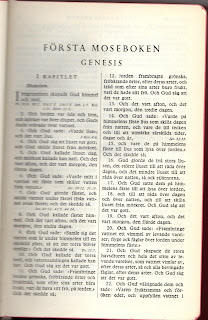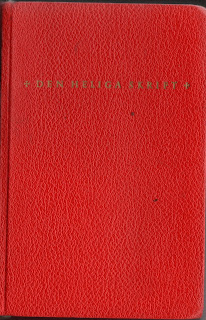I grew up with only a few stories about the old countries and fewer examples of their cultures. Most of what I got consisted of my grandfather telling how great Sweden's social safety net was (even though he'd never move there because he didn't like paying taxes) or my grandmother telling me about seeing tomtegubbens.
The only time I ever heard Swedish spoke was when my grandparents argued. My grandmother got a Norwegian-American newspaper but I never looked at it beyond its blue viking ship logo.
Once upon a time, though, Staten Island was practically overrun with all sorts of Scandinavians. Mostly Norwegians and mostly in Port Richmond. The churches they founded still remain (most notably Zion Lutheran and Salem Evangelical Free) as do the two Sons of Norway lodges.
Swedes were here in much lower numbers. Still, like their Norwegian brethren, a little of their legacy remains. The most explicitly Swedish thing, the Swedish Home for the Aged over in Sunnyside, was only shut down in the past three or four years. It didn't have enough residents to remain in operation.
Its centerpiece, a house once owned by the Vanderbilts, was torn down in the face of a request for landmark status from the preservationists. It might have survived if some sort of reasonable accommodation had been made with the new owners but that approach appears anathema to the preservationists.


Today it's got a small, faltering congregation, many of whom are of Swedish heritage. I own a copy of one of the church's last Swedish Bibles. I was allowed to take it because no one can read it anymore (including me).
Recently I learned of another surviving symbol of the Swedes sojourn on the Island. My aunt told me my grandfather belonged to something called Svea Lodge of the Swedish society, the Order of Vasa. They met in the building now used by the Alzheimer's Association.
A little research in my prized Leng and Davis books told me that not only had Svea Lodge met there but they had actually built the building. I wonder if under the marquees their something indicating the building's initial function.
 UPDATE: Well, I'm all red faced. I always thought my maternal grandmother's mom was Norwegian. Wrong! Turns out she was just another Swede Finn. And my grandfather was raised in Sweden by his grandmother. That's why, when my grandparents argued, it was in Swedish. It's probably the only time I ever heard it spoken in their house.
UPDATE: Well, I'm all red faced. I always thought my maternal grandmother's mom was Norwegian. Wrong! Turns out she was just another Swede Finn. And my grandfather was raised in Sweden by his grandmother. That's why, when my grandparents argued, it was in Swedish. It's probably the only time I ever heard it spoken in their house.






I grew up in Great Kills during the 60's..many of my neighbors were of Swedish and Norwegian heritage..so this all has a familiar flavor. I love that you're researching and writing about SI.
ReplyDeleteI grew up in the very Norwegian neighborhood of Westerleigh. My dad bought the family house in 1959 when he got a teaching job at Wagner College, which was then affiliated with the Lutheran Church. Many people at Wagner were Norwegian Lutherans and they invited my parents to join the new Bethany Lutheran Church, which had just moved to it's new home of Westcott Blvd., from it's old home on The Boulevard, across from PS 30 (the old church is now a VFW Post). I grew up around people with names like Jensen, Johnson, Sorenson, Knutsen, Larsen, etc. They were all very nice people but very strict in that spartan religious manner that seemed much too conservative to me as a teenager.
ReplyDelete1) Thanks, Sarah. I don't know much about the Great Kills community though I'm in the process of learning from a book a friend's aunt wrote about her family.
ReplyDelete2) Thanks, Ken. You just answered a question I've been wondering for some questions I've been wondering for some time. I knew a friend's wife grew up in a Norwegian evangelical church during the fifties and I'd longed suspected it was the VFW. Thank you for confirming it. I'd also wondered where Bethany had come from. The Norwegian move from Port Richmond to Westerleigh seems to have been going on from the fifties to the sixties with Zion Lutheran moving from Pt. Richmond around 1960. It's cool to still see the Norwegian flags in April.
Re: Zion move. Actually, the opposite is true. Norwegians began moving from Port Richmond much earlier than the 50's, so by the 50's and the change in the demographics of downtown PR, members didn't want to travel there. That's why they sold the original church and built the new building in Willowbrook.
DeleteMessiah Lutheran Church in Annadale is also a Swedish Lutheran Church - The Lutheran Churches in many cases were from country specific groups - German, Swedish & Norwegian - they merged into the ELCA - the main branch of most Lutherans in America. SI had German (Christ), Norwegian (Eltingville) and Swedish (Messiah)on the South Shore
ReplyDeleteI grew up in Trinity Lutheran which was the rich German brewers as opposed to the more working class Germans at St. Paul's over on Post Avenue (closed in the early 70s and merged with St. Luke's Swedish Lutheran Church over on Decker). St. John's Lutheran is German originally as was Immanuel over on Richmond Ave. Our Savior was more Norwegians. Fascinating history. From the little I know of the Catholic churches it was much the same way, albeit Irish, German, Polish and Italian.
ReplyDeleteBack in the early 1900's Zion and Our Saviour's were once one congregation. Then, the congregation split. I think it had to do with a class issue.The professionals and highly skilled founded Our Saviours and the workers, Zion.
DeleteCan you possible show me any places surrounding the Berry houses in dongan hills?
ReplyDeleteI generally don't do anything on the South Shore. If you give me some specific locations, I'll see what I can find - it involves sorting thru microfiche archives.
ReplyDeleteHi!
ReplyDeleteVery intressting reading. Do you have some more information about Pastor A.J Ostlin?
Its distance relevant, and i have been searching for more iformation about him and his children`s home Stanton.